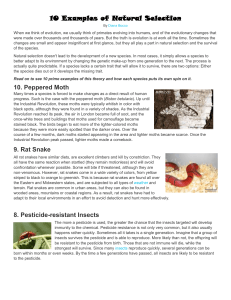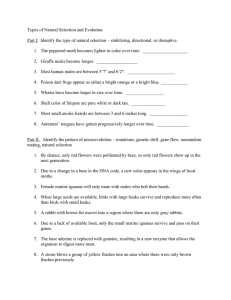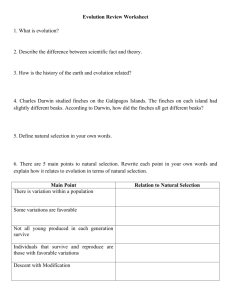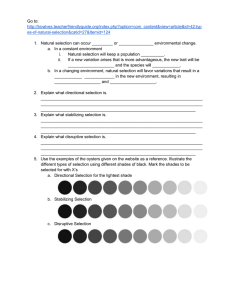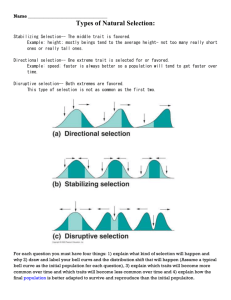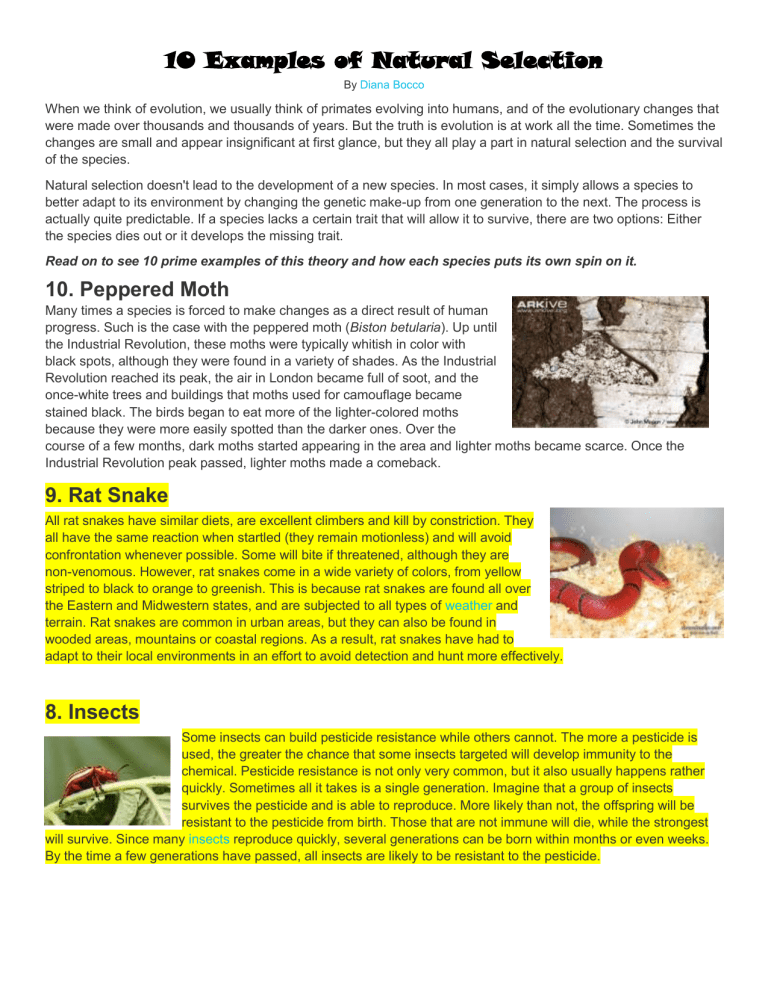
10 Examples of Natural Selection By Diana Bocco When we think of evolution, we usually think of primates evolving into humans, and of the evolutionary changes that were made over thousands and thousands of years. But the truth is evolution is at work all the time. Sometimes the changes are small and appear insignificant at first glance, but they all play a part in natural selection and the survival of the species. Natural selection doesn't lead to the development of a new species. In most cases, it simply allows a species to better adapt to its environment by changing the genetic make-up from one generation to the next. The process is actually quite predictable. If a species lacks a certain trait that will allow it to survive, there are two options: Either the species dies out or it develops the missing trait. Read on to see 10 prime examples of this theory and how each species puts its own spin on it. 10. Peppered Moth Many times a species is forced to make changes as a direct result of human progress. Such is the case with the peppered moth (Biston betularia). Up until the Industrial Revolution, these moths were typically whitish in color with black spots, although they were found in a variety of shades. As the Industrial Revolution reached its peak, the air in London became full of soot, and the once-white trees and buildings that moths used for camouflage became stained black. The birds began to eat more of the lighter-colored moths because they were more easily spotted than the darker ones. Over the course of a few months, dark moths started appearing in the area and lighter moths became scarce. Once the Industrial Revolution peak passed, lighter moths made a comeback. 9. Rat Snake All rat snakes have similar diets, are excellent climbers and kill by constriction. They all have the same reaction when startled (they remain motionless) and will avoid confrontation whenever possible. Some will bite if threatened, although they are non-venomous. However, rat snakes come in a wide variety of colors, from yellow striped to black to orange to greenish. This is because rat snakes are found all over the Eastern and Midwestern states, and are subjected to all types of weather and terrain. Rat snakes are common in urban areas, but they can also be found in wooded areas, mountains or coastal regions. As a result, rat snakes have had to adapt to their local environments in an effort to avoid detection and hunt more effectively. 8. Insects Some insects can build pesticide resistance while others cannot. The more a pesticide is used, the greater the chance that some insects targeted will develop immunity to the chemical. Pesticide resistance is not only very common, but it also usually happens rather quickly. Sometimes all it takes is a single generation. Imagine that a group of insects survives the pesticide and is able to reproduce. More likely than not, the offspring will be resistant to the pesticide from birth. Those that are not immune will die, while the strongest will survive. Since many insects reproduce quickly, several generations can be born within months or even weeks. By the time a few generations have passed, all insects are likely to be resistant to the pesticide. 7. Finches There are 13 types of Galapagos finches, also known as Darwin's Finches, and they share the same habits and characteristics except for one: All 13 have different beaks. The differences in their beaks might be the most important aspect of their survival. Two documented examples of that survival occurred in the late 1970s and mid 1980s. There are finches with large tough beaks that can eat largers seeds and there are finches with small beaks that are unable to crack the tough seeds but can eat smaller seeds. First, when a large drought affected the island in 1977, seeds became scarce. Finches with the largest, toughest beaks were able to eat larger seeds that weren't typically part of their diet. As a result, they survived. Finches with smaller beaks were unable to crack the tough seeds and many died. Through the process of natural selection, the birds that were able to adapt reproduced and thrived, while the others dwindled in number. However, adaptation can go both ways, as was seen during rainy weather in 1984 and 1985. The heavy rains created more of the small, soft seeds and few of the large ones. This time, more birds with the smaller beaks survived and produced more offspring. . 6. Peacocks The more impressive the tail of a male peacock, the higher its chances of finding a mate. Female peacocks choose mates based on the color of the feathers and the overall physical prowess of the animal. According to experts, the brightness of the plumage might signal to females that the animal has high-quality genes. This would make him ideal for reproduction and to ensure the survival of the offspring, so they're chosen first when it's time to mate. In reality, not all males have bright, large tails, and this was especially true a few thousand years ago. And because females kept choosing the brightest males as partners, the ones without the impressive tails were less likely to mate and reproduce. As a result, their numbers diminished from one generation to the next, making them rare today. 4. Warrior Ants The warrior ants in Africa are probably one of the most impressive examples of adaptation. Within any single colony, ants emit a chemical signal that lets the others know they all belong to the same compound. Or, put more simply, a signal that says "Don't attack me, we're all family." However, warrior ants have learned how to imitate the signal from a different colony. So if a group of warrior ants attacks a colony, they will be able to imitate that colony's signal. As a result, the workers in the colony will continue on, now under the direction of new masters, without ever realizing an invasion has taken place. 3. Deer Mouse Nebraska's Sand Hills is home to a deer mouse that's one of the quickest-evolving examples of natural selection in animals. The deer mouse is normally dark brown, which is a good color for mice living in the woods and surrounding areas, since it allows them to hide better and avoid predators. The deer mouse that lives in the Sand Hills, however, has evolved into a much lighter, sand-like color. Without this change, the deer mouse would be easily spotted by predators against the area's light terrain. Just one single gene had to change for the mouse's coat to become lighter. What's even more impressive? The change took only about 8,000 years, which is the equivalent to seconds in the evolutionary scale. 2. Lizards A number of studies have been done on lizards to determine natural selection. One experiment temporarily eliminated the lizards' natural predators from a forest area, and then scientists observed what impact that had on the lizards. The lizards with the longest legs were able to climb trees better, escape the ground when floods or storms came, and reach food that wasn't available down below. 1. Humans Are humans still evolving? The simple answer is yes, even if the changes are not obvious. Experts believe that about 9 percent of our genes are undergoing rapid evolution as we speak. The genes most affected by natural selection are those involving the immune system, sexual reproduction and sensory perception. An example is the sickle hemoglobin gene, which occurs in people who live in certain regions of Africa and other areas where malaria is endemic. This gene mutation makes people who have it more resistant to malaria. While they can still contract the disease, they are less likely to die from it. The mutation probably happened over hundreds of generations as a result of the constant exposure to malaria and people contracting and surviving it. http://dsc.discovery.com/tv-shows/curiosity/topics/10-examples-natural-selection.htm 10 Examples of Natural Selection Review Questions Write and answer the questions in your science notebook 1. How might pesticide resistant insects affect your life? 2. Which of the examples given has made the most beneficial adaptation in your opinion? Explain. 3. Which organism has developed the best adaptation for defense? Explain. 4. Assume, in humans, a bacteria were to become antibiotic resistant. How might that affect your life?
